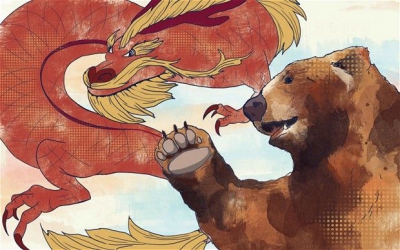Russia & China: The Bear and the Dragon. Earlier on today, the Russian ambassador in China posted a video on his Twitter feed celebrating the 160th anniversary of the founding of the city of Vladivostok. What he did not expect was the massive backlash his post created in China! Chinese diplomats, journalists and Weibo users denounced the post and lamented that Vladivostok was once called Haishenwai: The Russian region of Primorsky Krai, of which Vladivostok is the capital city, was once part of Manchuria.
The Chinese recriminations focussed on the fact that China was abused by European powers, Japan and Russia for a century (Called “Century of Humiliation” or “One Hundred Years of humiliation”). The time period ran from 1839 to 1949. During that time, China was occupied and forced to sign a series of what Beijing calls “Unequal Treaties”. China lists 21 such unequal treaties, each of which handed power, concessions or territories to foreign powers. In 1860, as China decisively lost the Second Opium War, The Chinese imperial prince was forced to sign the “Convention of Peking”: A collection of three treaties with Britain, France and Russia. Through this convention, The Brits added Kowloon to Hong-Kong, the French retrieved all religious (Christian) establishments that had been confiscated by the Chinese authorities and Russia acquired Outer-Manchuria, which included Primorsky Krai and the island of Sakhalin.
We tend to see Russia and China as allies or partners, but we forget that this position/perception is relatively new. Soviets and Chinese troops clashed in 1969 and the incident almost led to an all-out war. Moscow has always been weary of its large neighbour with which it shares 4,209km of common borders. Russia is all too aware that China can only look with envy at resource-rich Siberia and the strategic Far-East littoral. Moscow is also aware that while Russia has so far been the “senior” partner in the Russo-Chinese relationship, the situation is slowly and inexorably reversing.
Chinese-Russian cooperation is not new: The two countries often team up at the UN Security Council and sometimes share a common vision, as proven by the “Russian-Chinese joint declaration on a multipolar world and the establishment of a New International Order” which was adopted by both parties on the 23rd of April 1997! But the Sino-Russian rapprochement has only really gained momentum since the 2014 Russo-Ukrainian affair and the subsequent establishment of Western sanctions against Russia. Without said sanctions, it is doubtful that Russia would be so cosy with Beijing and there is no doubt that given a choice, Russia would prefer trading with its European partners.
In fact, while Xi Jinping and Vladimir Putin are often found smiling for the cameras, a quick look at a military map will show you that Russia has deployed no less than four 9K720 Iskander-M missile brigades in Russia’s Eastern Military District (facing China): Double the amount deployed in the Western Military District facing NATO! This speaks volumes about Russian worries concerning long-term Chinese intentions and ambitions.
Beijing might have already taken advantage of Moscow’s need to replace the lost Western investments in Russia: 70–80% of the investment in Primorsky Krai / Russian Far-East is Chinese. Moscow, rightly worried about the situation, has been trying to diversify its portfolio of foreign investors in the region. So far, both the Saudis and the Japanese have agreed to invest. In fact, Japan is actually only investing in the Russian region with the sole aim of trying to limit Chinese influence in and around Vladivostok!
We are not yet at a point where China will openly demand the “restitution” of this region from Russia. And we are not in a situation where we will see both countries go to war with one another. Not yet, anyway. But as China becomes more confident, more assertive, more powerful and more aggressive, this type of scenario will become increasingly realistic. How will the Bear adapt as the Dragon adopts the “wolf warrior” diplomacy?










